Animal Kingdom Important Extra Questions Very Short Answer Type
Question 1.
List the levels or grades of the organization
Answer:
- Cellular level
- Tissue level
- Organ level
- Organ- system level
Question 2.
Define the term incomplete digestive system.
Answer:
An incomplete digestive system has only a single opening to the outside of the body that serves as both mouth and anus.
Question 3.
Define the term complete digestive system.
Answer:
A complete digestive system has two openings, mouth, and anus.
Question 4.
Define the term open-type circulatory system.
Answer:
Open type, with the blood being pumped out of the heart and bathing the cells and tissues.
Question 5.
Define the term closed type circulatory system.
Answer:
Closed type, in which the blood is circulated through a series of tubes of varying diameters (arteries, veins, and capillaries)
Question 6.
Define radial symmetry.
Answer:
When any plane passing through the central axis of the body- divides the organism (like spokes of a bicycle wheel) into halves that approximately mirror images, it is called radial symmetry:
Question 7.
Define the bilateral symmetry
Answer:
Animals like annelids, arthropods, etc., where the body can be divided into identical left and right halves in only one plane, exhibit bilateral symmetry.
Question 8.
What is the diploblastic organization?
Answer:
Animals, in which the cells are arranged into two embryonic layers, external ectoderm and internal endoderm, are called diploblastic animals.
Question 9.
What is the triploblastic organization?
Answer:
Those animals in which the developing embryo has a third germinal layer, mesoderm, in between the ectoderm and endoderm are called triploblastic animals.
Question 10.
Define the coelom.
Answer:
The body cavity is lined by a mesoderm is called coelom.
Question 11.
Define the coelomates.
Answer:
Animals possessing coelom are called coelomates.
Question 12.
Define the acoelomates.
Answer:
The animals in which the body cavity is absent are called acoelomates.
Question 13.
What are pseudocoelomates?
Answer:
Such a body cavity is called pseudocolor and the animals possessing them are called pseudocoelomates.
Question 14.
Define metamerism.
Answer:
In some animals, the body has many segments, which show serial repetition of parts. This kind of segmentation is called metameric segmen¬tation, and the phenomenon is known as metamerism.
Question 15.
Name the major groups of the animals.
Answer:
- Invertebrates and
- Vertebrates
Question 16.
What are non-chordates and chordates?
Answer:
Animals are also grouped into nonchordates and chordates.
Question 17.
What are the sponges?
Answer:
Members of the Porifera phylum are commonly known as sponges.
Question 18.
Define the terms polyp and medusa.
Answer:
Cnidarians exhibit two basic body forms called polyp and medusa.
Question 19.
What is brain ganglion?
Answer:
Hooks and suckers possess a concentration of nervous tissue in the head called the brain ganglion.
Question 20.
Define the flame cells.
Answer:
Specialized cells called flame cells help in osmoregulation and excretion.
Question 21.
List the examples of Arthropoda.
Answer:
Charaxes (Butterfly), Musca (Housefly), Anax (Dragonfly), Lepisma (silverfish), Periplaneta (Cockroach) Apis (Bee), Buthus (Scorpion).
Question 22.
Give comments on Hemichordata in one sentence.
Answer:
Recently, M.J. (2005) has two placed Hemichordata as a phylum under Invertebrata.
Question 23.
Write one difference in chordates and non-chordates.
Answer:
Cordates, heart is ventral, non-chordates, heart is dorsal.
Question 24.
Give examples of Cyclostomata.
Answer:
Petromyzon (Lamprey) and Myxine (Hagfish)
Question 25.
Define colacal aperture.
Answer:
Alimentary canal, urinary and reproductive tracts open into a common chamber called the cloaca, which opens to the exterior through an aperture called cloaca! aperture.
Animal Kingdom Biology Important Extra Questions Short Answer Type
Question 1.
Discuss the level or grades of the organization.
Answer:
The kingdom Animalia includes multicellular heterotrophic animals, which exhibit different levels of organization as given below.
Cellular LevelAnimal such as sponges, which are loose associations of cells, fall into this group. Some division of labor (activities) occurs among the cells, but these cells do not organize themselves into a definite tissue.
Tissue Level Animals that have certain cells grouped together to form specific tissue are placed in this group, e.g. cnidarians and ctenophores.
Organ Level This is observed in animals that have different kinds of tissues organized into distinct organs each specialized for a particular function, e.g. some platyhelminths.
Organ-system Level Animals that have organs grouped together into functional systems, each system primarily concerned with a specific function are placed in this group, e.g., some platyhelminths, annelids, mollusks, arthropods, echinoderms, and chordates.
Question 2.
Discuss the types of patterns in the organ system.
Answer:
Various patterns of the complexity of organ systems serve as one of the useful criteria in classifying animals. For example, the digestive system may be absent, incomplete, or complete. An incomplete digestive system has only a single opening to the outside of the body that serves as both mouth and anus. A complete digestive system has two openings, mouth, and anus.
Similarly, the circulatory system may be of two types
- Open type, with the blood being pumped out of the heart and bathing the cells and tissues directly or,
- Closed Type, in which the blood is circulated through a series of tubes of varying diameters (arteries, veins, and capillaries).
Question 3.
Define radial symmetry and bilateral symmetry.
Answer:
Animals can be grouped into two categories based on symmetry. When any plane passing through the central axis of the body divides the organism (like spokes of a bicycle wheel) into halves that approximately mirror images, it is called radial symmetry. Cnidarians, ctenophores, and echinoderms have this kind of body plan (a).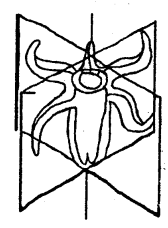
(a) Radial symmetry
Animals like annelids, arthropods, etc (b), where the body can be divided into identical left and right halves in only one plane, exhibit bilateral symmetry.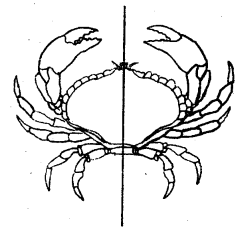
(b) Bilateral symmetry
Question 4.
Define the diploblastic and triploblastic organization.
Answer:
Animals, in which the cells are arranged into two embryonic layers, external ectoderm and internal endoderm, are called diploblastic animals in the below figure. Those animals in which the developing embryo has a third germinal layer, mesoderm, in between the ectoderm and endoderm are called triploblastic animals.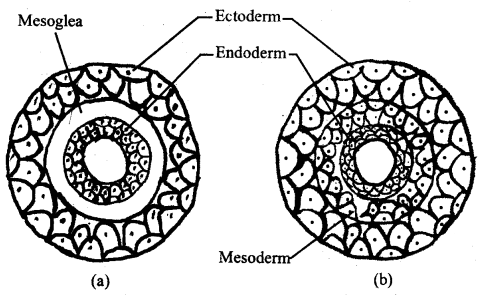
Showing germinal layers: (a) Diplobiastic (b) Triploblastic
Question 5.
Outline the role of body cavity and coelom in animals.
Answer:
The nature of the space (body cavity) between the body wall and alimentary canal is very important in the classification. The body cavity, which is lined by mesoderm is called a column. Animals possessing coelom are called coelomates (e.g. annelids, mollusks, arthropods, echinoderms,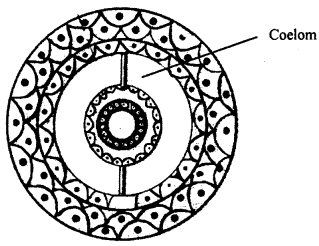
(a) Diagrammatic sectional view of Coelomate
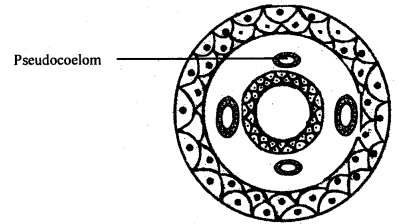
(b) Diagrammatic sectional view of Pseudocoelomate
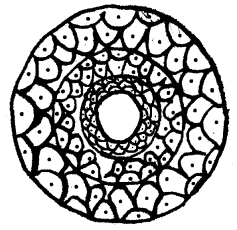
(c) Diagrammatic sectional view of Aceolomate
hemichordates and chordates) (a). The animals in which the body cavity is absent are called acoelomates (e.g., platyhelminths) (c). In some animals, the body cavity is not lined by mesoderm. Instead, the mesoderm is present as scattered pouches in between the ectoderm and endoderm. Such a body cavity is called pseudocolor and the animals possing them are called pseudocoelomates (e.g., as helminths) (b)
Question 6.
Define metamerism.
Answer:
In some animals (e.g., earthworm), the body has many segments, which show serial repetition of parts (like railway compartment). This kind of segmentation is called metameric segmentation, and the phenomenon is known as metamerism.
Question 7.
Draw the diagram broad classification of Kingdom Animalia based on common fundamental features.
Answer: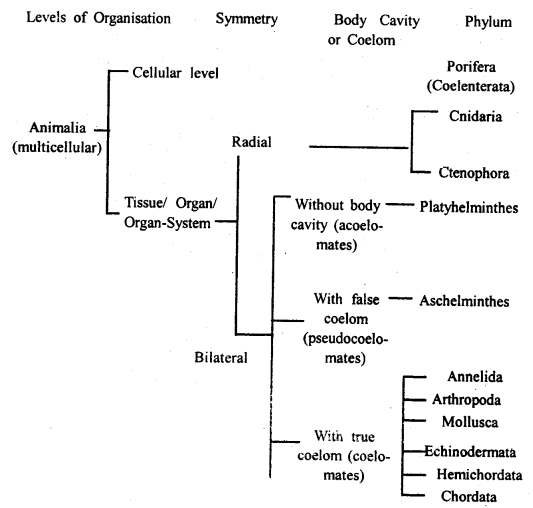
Question 8.
Describe the phylum Cnidaria.
Answer:
Cnidaria is aquatic, mostly marine, sessile, or free-swimming animals. The phylum name is derived from the stinging cells (nematocysts) or cnidoblasts present on the ectoderm of tentacles and on the body of these carnivorous animals. Cnidoblasts are used for anchorage, defense, and for capture of prey. Cnidarians exhibit tissue level of organization and exhibit radial symmetry. They are diploblastic.
The digestive system is incomplete. They have a central gastro-vascular cavity with a single opening, mouth. Digestion is extracellular and intracellular. Some of the cnidarians, e.g., corals, have skeletons composed of calcium carbonate.
Cnidarians exhibit two basic body forms called a polyp (e.g., Hydra) and medusa (e.g., Auralia). The former, a sessile and cylindrical form, whereas, the latter, umbrella-shaped and free-swimming. Those cnidarians which exist in both forms exhibit alternation of generation, i.e. polyps asexually produce medusae and medusae forming the polyps sexually (e.g., Ophelia)
Examples of cnidaria: Hydra, Porpita, Vellala, Physalia (Portuguese man-of-war), Aurelia (Jellyfish), Adamisia (Sea anemone), Pennatula (Sea- pen), Gorgonia (Sea-fan), and Meandrina (Brain coral).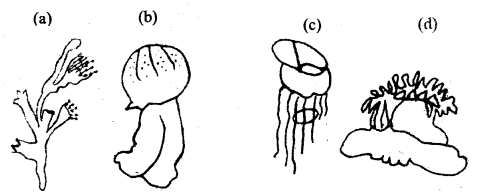
Some cnidarians (a) Obelia (b) Jellyfish (c) Physalia (d) Sea anemone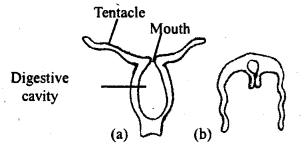
Polyp and medusa body from (a) sessile poy (b) swimming medusa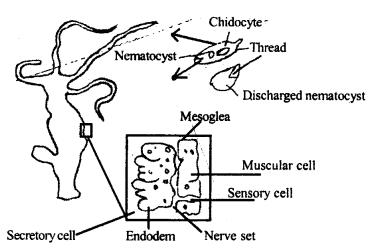
Structure of Hydra
Question 9.
Distinguish between the Chordates and Non-Chordates.
Answer:
| Chordates | Non-Chordates |
| 1. Notochord present. | 1. Notochord absent. |
| 2. Central nervous system is dorsal, hollow, and single. | 2. Central nervous system is ventral solid and double. |
| 3. Pharynx perforated by gill slices | 3. Gill slits are absent. |
| 4. Heart is ventral. | 4. Heart is dorsal. |
| 5. A post-anal (tail) is present. | 5. Past-anal tail is absent. |
Question 10.
Explain the class amphibia.
Answer:
As their name indicates (Gr. Amphi, dual, double + bios, life), most amphibians can exist in aquatic as well as terrestrial habitats. Most of them have two pairs of limbs. The body is divisible into the head and trunk; the tail may be present in some. The amphibian skin is moist (without scales). The eyes have eyelids. A tympanum represents the ear.
The alimentary canal, urinary and reproductive tracts open into a common chamber called the cloaca, which opens to the exterior through an aperture called the cloacal aperture. Respiration may be by gills, lungs, or through the skin. The heart is three-chambered (2 auricles and 1 ventricle). These are cold-blooded animals.
Sexes are separate Fertilization is external. They are oviparous and development is direct or indirect.
Examples of Amphibia: Bufo (Toad), Rana (Frog), Hyla (Tree frog),
Salamandra (Salamander), Ichthyophis (Limbless amphibia).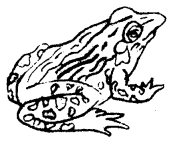
Frog
Question 11.
Describe the class Reptilia.
Answer:
The class name refers to their creeping or crawling mode of locomotion. They are mostly terrestrial animals with a body covered by dry and cornified skin, epidermal scales, or scutes. They do not have external ear openings. Limbs, when present, are two pairs. The heart is usually three-chambered, but four-chambered in crocodiles, Reptiles are cold-blooded animals. The excretory organ is the kidney. Snakes and lizards shed their scales as skin cast.
Sexes are separate. Fertilization is internal. They are oviparous and development is direct.
Examples of Reptilia T Chelone (Turtle), Testudo (Tortoise), Chameleon (Tree lizard), Calotes (Garden lizard), Naja (Cobra), Crocodilus (Croco¬dile), Aligator (Alligator).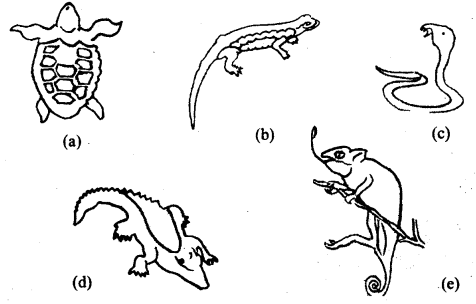
(a) Tortoise, (b) Monitor (Indian goh) (c) Naja (d) Crocodile (e) Chameleon
Question 12.
Explain the important characteristics of Mammalia.
Answer:
Mammalia is generally terrestrial, found in a variety of habitats- polar ice caps, deserts, mountains, forests, grasslands, and dark cover. Some of them have even adapted to fly or live in water. The most unique mammalian characteristic is the presence of milk-producing glands (mammary glands) by which the young ones are nourished.
Mammalia has two pairs of limbs, which are variously adapted for walking, running, climbing, burrowing, swimming, and flying. The skin of mammals is unique in possessing hairs. External ears or pinnae are present. Different types of teeth are present in the jaw. The heart is four-chambered. The lungs are well developed. Mammals show the greatest intelligence among all the animals.
Sexes are separate and fertilization is internal. They are viviparous with few exceptions and development is direct.
Some mammals: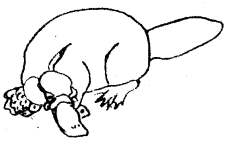
Ornithorhynchus
Balaenoptera
Pteropus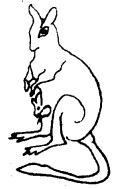
Macropus
Question 13.
Describe the main characteristic of class-Aves.
Answer:
The characteristic features of birds are the presence of feathers and most of them can fly with few exceptions, generally called flightless birds (e.g. Ostrich). They possess beak. The forelimbs are modified into wings. The hind limbs generally have scales and are modified for walking, swimming, or clasping the tree branches. Skin is dry without glands except for the oil gland at the base of the tail. The endoskeleton is fully ossified (bony) and the long bones are hollow with air cavities.
The digestive tract of birds has additional chambers, the crop, and the gizzard. The heart is completely four-chambered. They are warm-blooded (homeotherms) animals, i.e., they are able to maintain constant body temperature. Respiration is by lungs that contain air sacs. Birds have a good sense of sight. The excretory organ is a kidney.
Sexes are separate. Fertilization is internal. They are oviparous and development is direct. Examples of Aves are Corvus (crow), Columba (pigeon), Prittacula (parrot), Struthio (Ostrich) Paver (Peacock), Aptenodytes (Penguin)
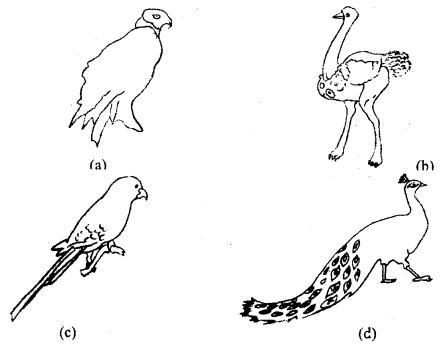
Some birds : (a) Neophron (b) Struthio (c) Psittacula (d) Pavo
Question 14.
Write some basic characterize- features of the following Phyla:
Ctenophora, Annelida, Mo.llusca, Echino Desmata and Hemichordata.
Answer:
Represents some basic characteristic features of different phyla.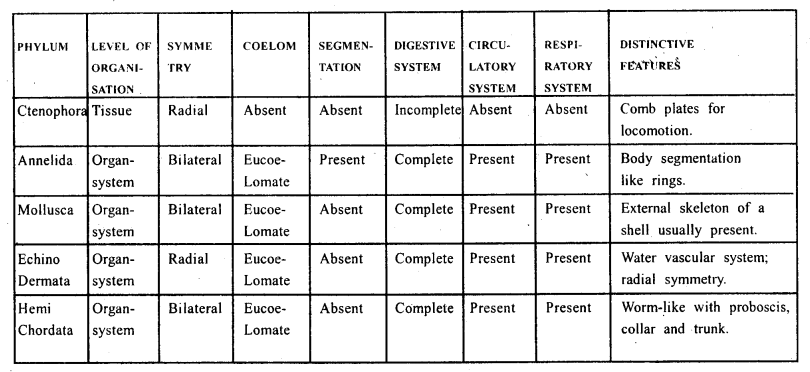
Question 15.
Draw the diagram of the classification of phylum Chordata.
Answer: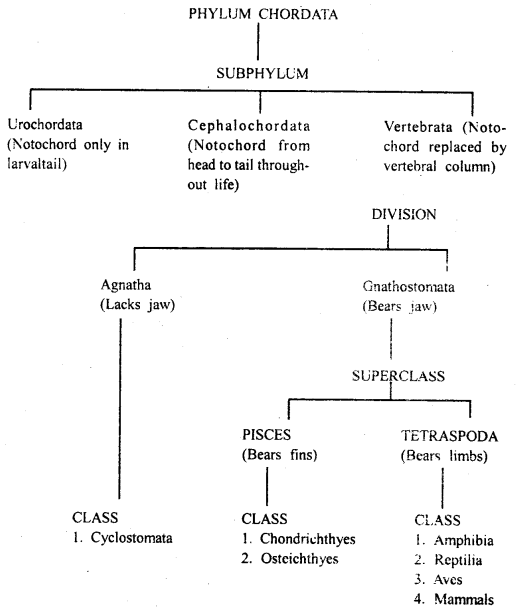
Classification of phylum Chordata
Animal Kingdom Biology Important Extra Questions Long Answer Type
Question 1.
Describe the phylum Arthropods.
Answer:
The phylum Arthropoda is the largest phylum of the animal kingdom consisting of more than 900,000 species, which include many economically important insects.
- They have an organ-system level of body organization. They are bilaterally symmetrical, triploblastic, segmented, and acoelomate animals.
- The body of arthropods is covered by a chitinous cuticle which forms the exoskeleton. The body segments are fused to form the head, thorax, and abdomen.
- They have jointed appendages. The appendages are variously modified to form antennae, mouthparts, pincers (chelicerae), or walking legs.
- The digestive system is complete.
- Respiratory organs are gills, book gills, book lungs, or tracheal system.
- The circulatory system is open type.
- The nervous system is almost similar to that of the annelids. Sensory organs include antennae for perceiving odor, receptors for taste, eyes (compound and simple), statocysts or balance, organs, and sound receptors.
- Excretion takes place through green glands or malpighian tubules.
- They are mostly dioecious. Reproduction is sexual. Fertilization is usually internal. They are mostly oviparous.
Development may be direct or indirect, passing through many larval stages. The process of transformation of a larva into an adult is called metamorphosis.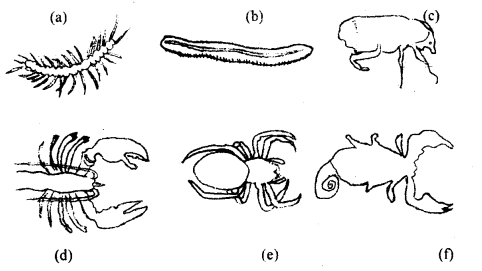
Some common arthropods (a) Centipede (b) Millipede (c) Beetle (d) Prawn (e) Spider and (f) Scorpian
Examples of Arthropoda: Araneus (Garden spides), Limulus (King crab),
Buthus (Scorpion), Scolopendra (Centipede), Cancer (Common crab), Balanus (Barnacle), Lepisma (Silverfish), Periplaneta (Cockroach), Apis (Bee) Anopheles (Mosquito), Musca (Housefly), Charaxes (Butterfly), Attelabus (Beetle), Locusta (Locust) and An ax (Dragonfly).
Question 2.
Describe the phylum Porifera.
Answer:
Members of this phylum are commonly known as sponges. They are generally marine, diploblastic bilaterally symmetrical with a significant water transport mechanism. They are considered as very primitive multi-cellular animals and have a cellular level of organization.
Water can enter through minute pores (Ostia) in the body wall directly or through the canal into a central cavity, spongocoel, from where it goes out through the osculum.
This pathway of water transport is called the canal system and is helpful in food gathering, respiratory exchange, and removal of water. Choanocytes or collar cells line the spongocoel and the canals. Digestion is intracellular. The body is supported by a skeleton made up of spicules or spongin fibers.
Sexes are not separate (monoecious/hermaphrodite/bisexual), i.e., eggs and sperms are produced by the same individual. Sponges reproduce asexually by fragmentation and sexually by the formation of gametes. Fertilization is internal and development is indirect having a larval stage that is morphologically distinct from the adult.
Examples of Porifera are Sycon (Scypha), Spongilla, Chalina, (Dead man’s finger), and Euspongia (Bath sponge)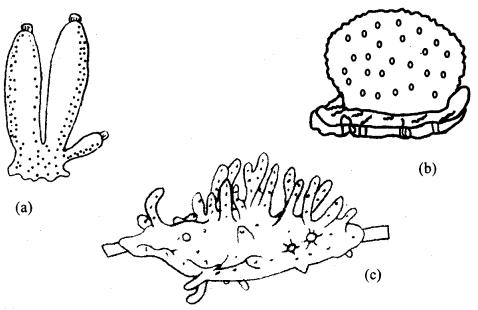
Examples for Porifera: (a) Sycon (b) Euspongia (c) Spongilla










